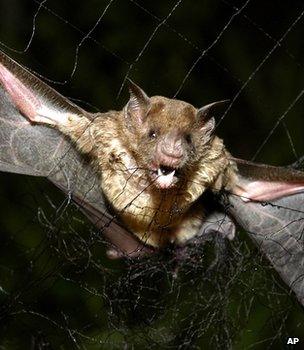Culling bats does not halt rabies, says report
- Published

Common vampire bats are a natural reservoir for the rabies virus
Culling vampire bats in South American nations does not curb the spread of rabies, in fact it could actually be counterproductive, a study suggests.
Until now, it had been assumed that controlling bat numbers would, in turn, control the spread of the rabies virus.
Researchers say rabies is found in most bat populations, but vampire bats - which feed on mammals' blood - are responsible for most infections.
The <link> <caption>findings have been published in the Proceedings of the Royal Society B</caption> <url href="http://rspb.royalsocietypublishing.org/lookup/doi/10.1098/rspb.2012.0538" platform="highweb"/> </link> .
"We found that rabies is there no matter what," said co-author Daniel Streicker, an ecologist at the University of Georgia, US.
"The size of the bat colony didn't predict the proportion of bats that were exposed to the virus.
"That's important because if there is no relationship between bat population density and rabies, then reducing the bat population won't reduce rabies transmission within bats."
For about three decades, the main focus in Peru to halt the spread of the virus - which is transmitted from animals to humans or livestock, and results in death if left untreated - has been to cull common vampire bats ( <italic>Desmodus rotundus)</italic> using poisons, or even explosives.
The researchers, writing in their paper, explained that the data they collected over a 40-month period from 20 sampling sites revealed that culling was not having the desired effect.
In fact, Dr Streicker explained, the findings suggested that culling had a potentially counterproductive impact.
"In areas that were sporadically culled during the course of the study, we saw an increase in the proportion of bats exposed to rabies," he said.
Colonies that were frequently culled had slightly lower rates, the study showed, yet the ones that had never been culled had the lowest rates of all.
It is suggested that increasing levels of human encroachment into areas with vampire bat populations has exacerbated the problem.
Dr Streicker and the team said the study would continue for another two years, with the goal of developing a scientific-based solution.
The researchers hope the findings will help deliver a more effective method to protect public health and agricultural interests from the virus.
- Published4 August 2011